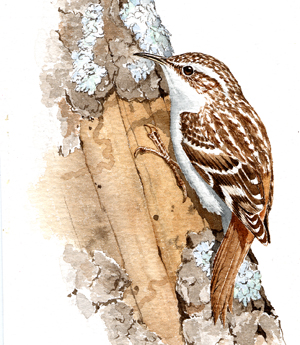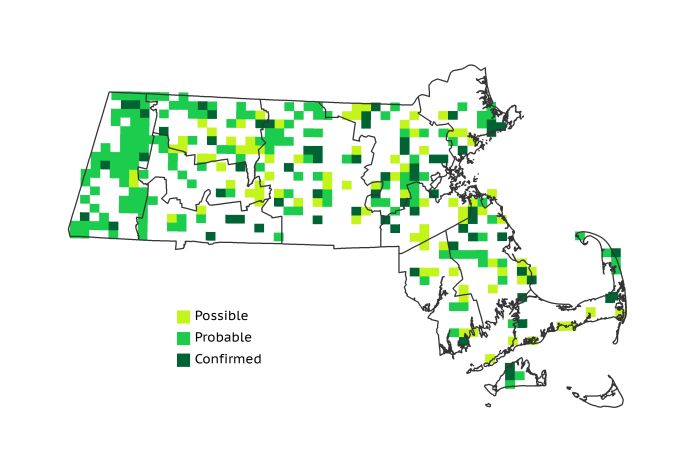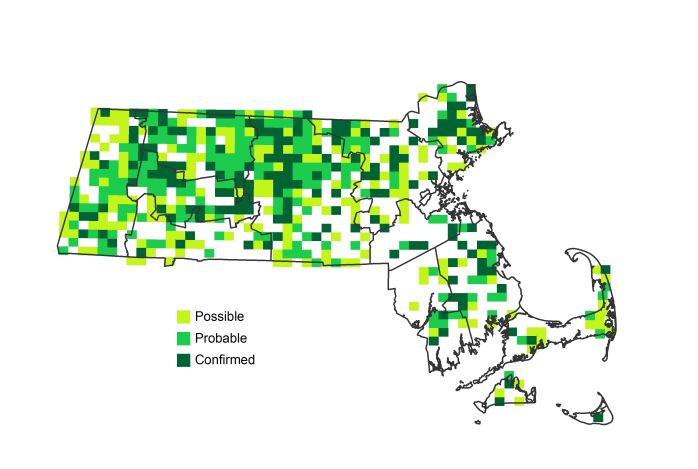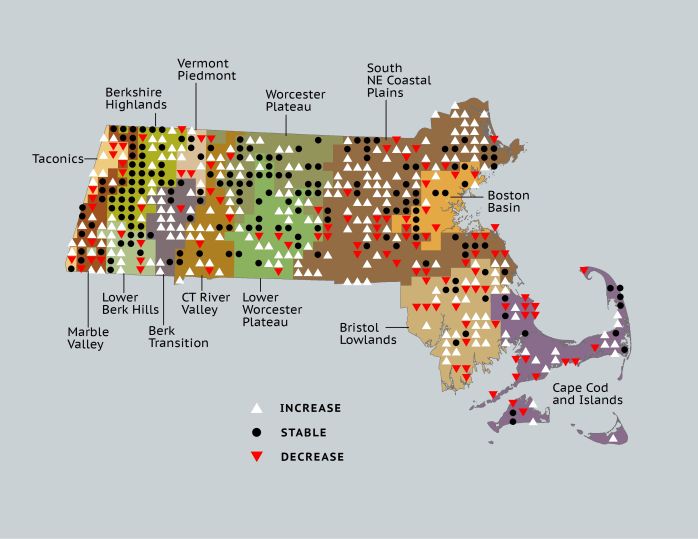Find a Bird
Brown Creeper
Certhia americana

Widespread and likely increasing

“The little American Brown Creeper is nothing if not thorough; he goes to the bottom of things; and having reached his objective, he climbs. He seems to be actuated by the motto ‘Excelsior!’, which is a good one for man or bird.” – Edward Howe Forbush, Birds of Massachusetts and Other New England States
Though they are the only American representatives of the treecreeper family Certhiidae, Brown Creepers are a fixture of the New England woods. Like tiny pieces of moving bark, these cryptic birds inch along the trunks of mature trees, pecking and probing for invertebrate prey. They are easily overlooked, but Atlas efforts have unearthed an apparent increase in creeper distribution over the past few decades.
Historic Status
Massachusetts' earliest ornithologists did not believe that Brown Creepers nested within the borders of the state. By the middle and latter parts of the nineteenth century, they could be swayed. Although generally the species was considered primarily a migrant, they began to also take note of breeding in coniferous forests, especially in Berkshire County and sporadically elsewhere (Howe & Allen 1901). As the state reforested in the twentieth century following the decline of agriculture, the Brown Creeper population increased. This growth may have been partially spurred on by the loss of American Elm trees to Dutch Elm disease across the state (Davis 1978).
Atlas 1 Distribution
Atlas 1 apparently documented Brown Creepers in the midst of a range expansion in Massachusetts. The species was once primarily associated with highland forests in the west and the Worcester Plateau, and they continued to be fairly well distributed in these areas. The western Berkshire Highlands (67% occupancy) and parts of the Marble Valleys (64%) were particularly favored, but no region was completely devoid of creepers. Though more thinly distributed through the Berkshire Transition and Connecticut River Valley, Brown Creepers were found in more than a third of blocks in both the Worcester and Lower Worcester Plateaus. The Coastal Plains reported breeding Brown Creepers throughout the region, with a particular concentration on the eastern border with the Boston Basin. Although Brown Creepers were somewhat local at best in the Lowlands and the Cape and Islands, they were found in better than 20% of blocks in each of these regions, especially where mature wet forest habitat was available.
Atlas 2 Distribution and Change
Brown Creepers made a conservative move in Massachusetts between the two Atlas projects. Rather than push their way into the eastern parts of the state, they instead primarily expanded their distribution in their historic western strongholds. From the Worcester Plateau west the growth was determinedly strong, especially in the Berkshire Transition, in which Brown Creepers conquered half the region in addition to their existing holdings. In small pockets in the east, Brown Creepers did expand, particularly in Essex County and the Bristol/Narragansett Lowlands. Through much of the region, though, the key word for the species was stability.
Atlas 1 Map

Atlas 2 Map

Atlas Change Map

Ecoregion Data
Atlas 1 | Atlas 2 | Change | ||||||
Ecoregion | # Blocks | % Blocks | % of Range | # Blocks | % Blocks | % of Range | Change in # Blocks | Change in % Blocks |
Taconic Mountains | 6 | 37.5 | 1.9 | 12 | 48.0 | 2.2 | 2 | 13.3 |
Marble Valleys/Housatonic Valley | 25 | 64.1 | 8.0 | 29 | 74.4 | 5.4 | 4 | 10.3 |
Berkshire Highlands | 37 | 67.3 | 11.8 | 48 | 87.3 | 8.9 | 10 | 18.9 |
Lower Berkshire Hills | 11 | 39.3 | 3.5 | 21 | 67.7 | 3.9 | 7 | 25.9 |
Vermont Piedmont | 8 | 47.1 | 2.5 | 13 | 76.5 | 2.4 | 1 | 8.3 |
Berkshire Transition | 9 | 23.7 | 2.9 | 29 | 72.5 | 5.4 | 15 | 48.4 |
Connecticut River Valley | 14 | 25.0 | 4.5 | 35 | 53.8 | 6.5 | 12 | 25.0 |
Worcester Plateau | 33 | 42.3 | 10.5 | 81 | 92.0 | 15.0 | 16 | 33.3 |
Lower Worcester Plateau | 28 | 37.8 | 8.9 | 51 | 63.8 | 9.5 | 11 | 20.4 |
S. New England Coastal Plains and Hills | 76 | 28.1 | 24.2 | 142 | 50.2 | 26.3 | 42 | 18.6 |
Boston Basin | 13 | 23.2 | 4.1 | 10 | 17.9 | 1.9 | -3 | -5.5 |
Bristol and Narragansett Lowlands | 25 | 23.6 | 8.0 | 34 | 29.8 | 6.3 | 10 | 9.9 |
Cape Cod and Islands | 29 | 21.3 | 9.2 | 34 | 23.6 | 6.3 | 1 | 0.8 |
Statewide Total | 314 | 32.4 | 100.0 | 539 | 52.0 | 100.0 | 128 | 15.4 |
Notes
The Brown Creeper shows a significant increasing Breeding Bird Survey trend in the Eastern US overall.



